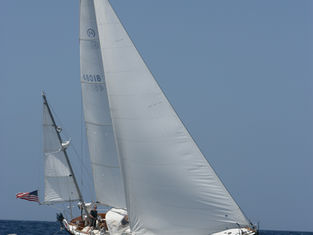
About Song
My wife, Anne, and I purchased Song in September 1999 through the Hinckley Yacht Brokerage in Southwest Harbor, Maine. Designed by William H Tripp Jr., the Hinckley H-48 was a direct descendant of the iconic Bermuda 40—one of the most successful American production sailboats ever built, with 203 hulls launched.
Since then, I’ve sailed Song over 80,000 nautical miles. We’ve cruised the Mediterranean from Spain to Turkey, and from Italy to Tunisia. Beginning in 2006, I’ve made annual passages from Newport to the Caribbean, sailing as far north as Nova Scotia and as far south as Cartagena, Colombia.

Song is set up for serious offshore cruising: sturdy handholds throughout, leeboards, snug sea berths, and a high bridgedeck. Over the years, I’ve made key upgrades—including an inner forestay with running backstays, and a full suite of updated electronics: AIS, radar, instruments, and a modern chart plotter.
In February 2025, I began a new refit at Hinckley Yacht Services. We’re replacing the engine, generator, and stove, and installing a hydrogenerator, solar panels, and additional batteries—getting Song ready for her next major passage. (You can view photos and videos of the refit here.)
Below deck, Song sleeps eight. Her interior features birch paneling with mahogany trim, and all hardware is either stainless steel or chrome. The forward cabin includes a V-berth, overhead hatch, drawers, shelving, and a hanging locker. Aft of the salon is a head with a shower. The main salon itself features pilot and transom berths on both sides, a fold-out mahogany dining table for eight, and even a wood-burning fireplace. Beneath the berths are multiple storage drawers. The galley has a new gimbaled Force 10 stove and rebuilt refrigerator/freezer. Opposite is the navigation station, equipped with
a DC breaker panel, instruments, and three chart-sized drawers. Further aft is a private cabin with a double and quarter berth, plus another head and shower.
On deck, I’ve preserved as much of the original Hinckley detailing as possible. The original masts remain, each with one set of teak spreaders. The winches are traditional, non-self-tailing, and I’ve retained most of the original blocks—upgrading only where necessary.
To refine headsail trim under load, I replaced the traditional adjustable cars with pad-eyes forward of the shrouds. These run Antal low-friction rings through which trimmer sheets are led and soft-shackled to the genoa sheets, allowing real-time trim adjustments without needing to unload pressure.
On the foredeck, I’ve added an inner forestay with a Harken tensioner and running backstays. The backstay also has a Harken adjuster, and I use a mechanical boom vang. The autopilot is a Raymarine Type-II rotary motor, fitted with reducer sprockets and pillow blocks to ease the load by a 2:1 ratio. I carry two backup motors.
During the refit, I installed two 150-amp solar panels on the dodger. Combined with the new hydrogenerator, this setup should eliminate the need to run the generator. Still, the Fischer Panda AGT 5000 DC generator (added during the refit) delivers 280 amps while consuming just 0.2 gallons of diesel per hour.
All Raymarine electronics are new, including Doppler radar, AIS, autopilot head, instruments, and a touchscreen chart plotter. I also have a full inventory of new Doyle sails: main, mizzen, genoa, staysail, storm tri-sail, storm staysail, gennaker, plus a spare main and headsail. We also installed a new 57-horsepower Yanmar 4JH57 auxiliary engine.

A Brief History of the H-48
In 1933, Henry Hinckley built his first production wooden sailboat, the Sou’wester 34 Huntress, designed by Sparkman & Stephens. His company, then known as Southwest Harbor Boat Yard, would go on to become the Henry R. Hinckley Company and produce a line of distinguished wooden yachts, including the Pilot 35, Sou’wester 30, Sou’wester 42, and various custom designs. These boats were crafted from Honduras mahogany planking, white oak frames, and featured teak decks and brightwork, with interiors finished in mahogany or teak.
In 1959, Hinckley asked William Tripp Jr. to design their first fiberglass sailboat, the Bermuda 40. Unlike many competitors, Hinckley embraced fiberglass early and aggressively. The result was a yacht that became an American classic: a yawl-rigged, moderate-displacement, full-keel cruiser with a graceful sheer, sweeping bow, and overhanging stern. The centerboard allowed for shallow-water access while maintaining excellent upwind performance. With more than 200 sold, the Bermuda 40 became a defining model for Hinckley.
In 1965, a group of Bermuda 40 owners approached Henry Hinckley asking for a larger version of the boat they loved. Once again, Tripp was commissioned, this time to design the H-48.
The H-48 carried forward the elegant lines of the B-40: sweeping sheer, spoon bow, and counter stern. Only 15 H-48s were built between 1965 and 1973, making it one of the rarest Hinckley models. At 48.25 feet LOA with a beam of 13 feet, she displaced 36,000 pounds and carried 10,600 pounds of lead ballast. The long keel was fitted with an electrically operated worm-gear centerboard, giving her a draft range from 5.17 to 11.75 feet. Most were yawl-rigged, though a few were ordered as sloops.
Song is the 15th and final H-48 built.







